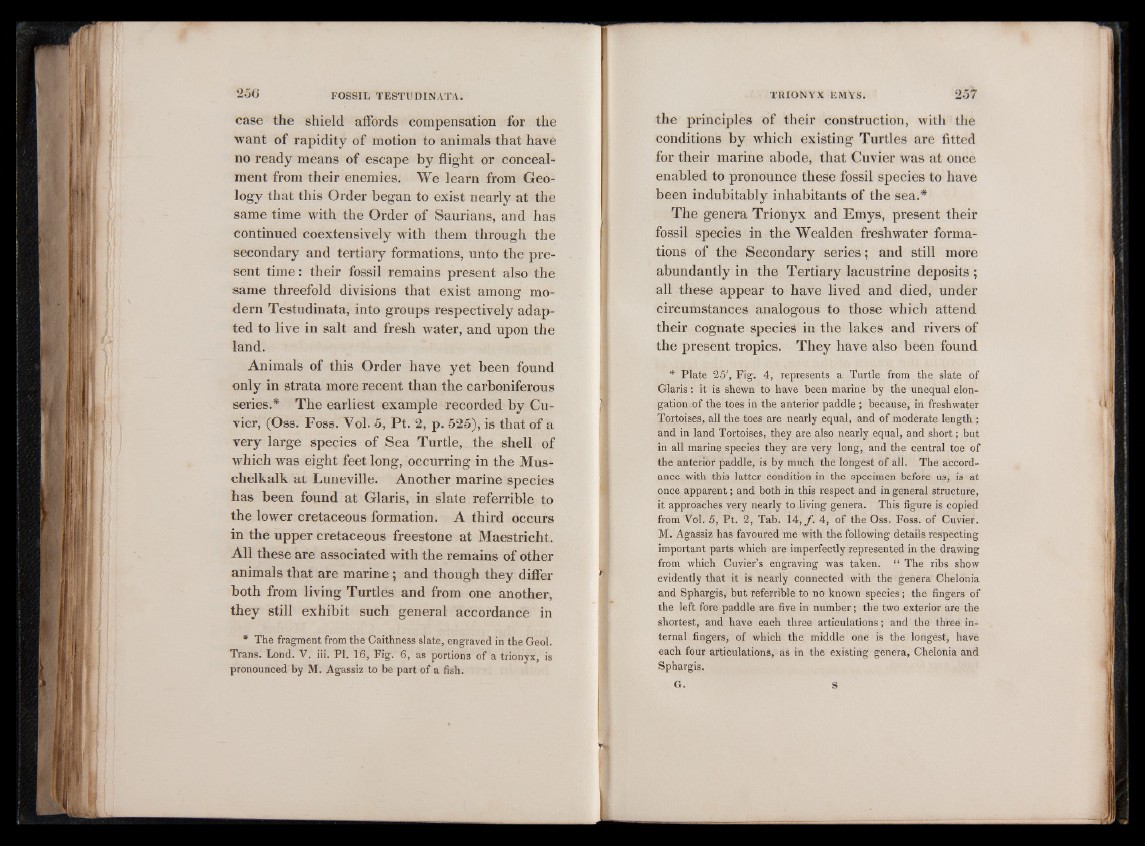
case the shield affords compensation for the
want of rapidity of motion to animals that have
no ready means of escape by flight or concealment
from their enemies. We learn from Geology
that this Order began to exist nearly at the
same time with the Order of Saurians, and has
continued coextensively with them through the
secondary and tertiary formations, unto the present
time : their fossil remains present also the
same threefold divisions that exist among modern
Testudinata, into groups respectively adapted
to live in salt and fresh water, and upon the
Land.
Animals of this Order have yet been found
only in strata more recent than the carboniferous
series.* The earliest example recorded by Cuvier,
(Oss. Foss. Yol. 5, Pt. 2, p. 525), is that of a
very large species of Sea Turtle, the shell of
which was eight feet long, occurring in the Mus-
chelkalk at Luneville. Another marine species
has been found at Glaris, in slate referrible to
the lower cretaceous formation. A third occurs
in the upper cretaceous freestone at Maestricht.
All these are associated with the remains of other
animals that are marine ; and though they differ
both from living Turtles and from one another,
they still exhibit such general accordance in
* The fragment from the Caithness slate, engraved in the Geol.
Trans. Lond. V. iii. PI. 16, Fig. 6, as portions of a trionyx, is
pronounced by M. Agassiz to be part of a fish.
the principles of their construction, with the
conditions by which existing Turtles are fitted
for their marine abode, that Cuvier was at once
enabled to pronounce these fossil species to have
been indubitably inhabitants of the sea.*
The genera Trionyx and Emys, present their
fossil species in the Wealden freshwater formations
of the Secondary series; and still more
abundantly in the Tertiary lacustrine deposits ;
all these appear to have lived and died, under
circumstances analogous to those which attend
their cognate species in the lakes and rivers of
the present tropics. They have also been found
* Plate 25', Fig. 4, represents a Turtle from the slate of
Glaris: it is shewn to have been marine by the unequal elongation
of the toes in the anterior paddle ; because, in freshwater
Tortoises, all the toes are nearly equal, and of moderate length ;
and in land Tortoises, they are also nearly equal, and short; but
in all marine species they are very long, and the central toe of
the anterior paddle, is by much the longest of all. The accordance
with this latter condition in the specimen before us, is at
once apparent; and both in this respect and in general structure,
it approaches very nearly to living genera. This figure is copied
from Vol. 5, Pt. 2, Tab. 14, f . 4, of the Oss. Foss, of Cuvier.
M. Agassiz has favoured me with the following details respecting
important parts which are imperfectly represented in the drawing
from which Cuvier’s engraving was taken. “ The ribs show
evidently that it is nearly connected with the genera Chelonia
and Sphargis, but referrible to no known species; the fingers of
the left fore paddle are five in number; the two exterior are the
shortest, and have each three articulations; and the three internal
fingers, of which the middle one is the longest, have
each four articulations, as in the existing genera, Chelonia and
Sphargis.
G. S